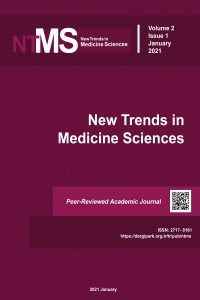Abstract
Pterygium is one of the most controversial ocular diseases whose pathology is not yet known. Although it is defined as a benign lesion, it behaves similar to tumor formation due to epithelial and fibrovascular overgrowth on the ocular surface. DNA methylation of specific genes as an epigenetic regulatory mechanism plays critical roles in the pathogenesis, progression, diagnosis, and treatment of many cancers. The E-cadherin gene is involved in cell metabolism and is known to be associated with multiple tumor malignancies. In this study, we evaluated the possible relationship of the E-cadherin gene methylation profile with pterygium. E-cadherin gene promoter methylation profile was determined using methylation-specific PCR (MSP) method in tissue samples of a total of 36 patients with pterygium. According to the data obtained, the percentage of methylation of the E-cadherin gene in tissues with pterygium was statistically significant compared to the control group (p<0,005). Methylation in the E-cadherin gene is thought to be related to pterygium formation and development.
Keywords
Supporting Institution
Tokat Gaziosmanpaşa University Scientific Research Projects Directorate
Project Number
2019/40
References
- Anguria P, Kitinya J, Ntuli S, Carmichael T. The role of heredity in pterygium development. Int J Ophthalmol. 2014;7(3):563–573.
- Jaworski CJ, Aryankalayil-John M, Campos MM, Fariss RN, Rowsey J, et al. Expression analysis of human pterygium shows a predominance of conjunctival and limbal markers and genes associated with cell migration. Mol Vis. 2009;15:2421–2434.
- Aslankurt M, Astam N. Pterjium etiyolojisi. Tıp Araştırmaları Derneği.2003
- Riau AK, Wong TT, Finger SN, Chaurasia SS, Hou AH, et al. Aberrant DNA methylation of matrix remodeling and cell adhesion-related genes in pterygium. PLoS One. 2011;6(2).
- Perra MT, Colombari R, Maxia C, Zucca I, Piras F, et al. Finding of conjunctival melanocytic pigmented lesions within pterygium. Histopathology. 2006;48(4):387–393.
- Chui J, Coroneo MT, Tat LT, Crouch R, Wakefield D, et al. Ophthalmic pterygium: A stem cell disorder with premalignant features. Am J Pathol. 2011;178(2):817–827.
- Solomon AS. Pterygium. Br J Ophthalmol. 2006;90(6):665–666.
- He S, Sun H, Huang Y, Dong S, Qiao C, et al. Identification and Interaction Analysis of Significant Genes and MicroRNAs in Pterygium. Biomed Res Int. 2019.
- Gall TMH, Frampton AE. Gene of the month: E-cadherin (CDH1). J Clin Pathol. 2013;66(11):928–932.
- Jeanes A, Gottardi CJ, Yap AS. Cadherins and cancer: How does cadherin dysfunction promote tumor progression? Oncogene. 2008;27(55):6920–6929.
- Young CH, Chiu Y Te, Shih TS, Lin WR, Chiang CC, et al. E-cadherin promoter hypermethylation may contribute to protein inactivation in pterygia. Mol Vis. 2010;16:1047–1053.
- Esteller M. CpG island hypermethylation and tumor suppressor genes: A booming present, a brighter future. Oncogene. 2002;21:5427–5440.
- Mendonsa AM, Na TY, Gumbiner BM. E-cadherin in contact inhibition and cancer. Oncogene. 2018;37(35):4769–4780.
- Van Roy F, Berx G. The cell-cell adhesion molecule E-cadherin. Cell Mol Life Sci. 2008;65(23):3756–3788.
Abstract
Project Number
2019/40
References
- Anguria P, Kitinya J, Ntuli S, Carmichael T. The role of heredity in pterygium development. Int J Ophthalmol. 2014;7(3):563–573.
- Jaworski CJ, Aryankalayil-John M, Campos MM, Fariss RN, Rowsey J, et al. Expression analysis of human pterygium shows a predominance of conjunctival and limbal markers and genes associated with cell migration. Mol Vis. 2009;15:2421–2434.
- Aslankurt M, Astam N. Pterjium etiyolojisi. Tıp Araştırmaları Derneği.2003
- Riau AK, Wong TT, Finger SN, Chaurasia SS, Hou AH, et al. Aberrant DNA methylation of matrix remodeling and cell adhesion-related genes in pterygium. PLoS One. 2011;6(2).
- Perra MT, Colombari R, Maxia C, Zucca I, Piras F, et al. Finding of conjunctival melanocytic pigmented lesions within pterygium. Histopathology. 2006;48(4):387–393.
- Chui J, Coroneo MT, Tat LT, Crouch R, Wakefield D, et al. Ophthalmic pterygium: A stem cell disorder with premalignant features. Am J Pathol. 2011;178(2):817–827.
- Solomon AS. Pterygium. Br J Ophthalmol. 2006;90(6):665–666.
- He S, Sun H, Huang Y, Dong S, Qiao C, et al. Identification and Interaction Analysis of Significant Genes and MicroRNAs in Pterygium. Biomed Res Int. 2019.
- Gall TMH, Frampton AE. Gene of the month: E-cadherin (CDH1). J Clin Pathol. 2013;66(11):928–932.
- Jeanes A, Gottardi CJ, Yap AS. Cadherins and cancer: How does cadherin dysfunction promote tumor progression? Oncogene. 2008;27(55):6920–6929.
- Young CH, Chiu Y Te, Shih TS, Lin WR, Chiang CC, et al. E-cadherin promoter hypermethylation may contribute to protein inactivation in pterygia. Mol Vis. 2010;16:1047–1053.
- Esteller M. CpG island hypermethylation and tumor suppressor genes: A booming present, a brighter future. Oncogene. 2002;21:5427–5440.
- Mendonsa AM, Na TY, Gumbiner BM. E-cadherin in contact inhibition and cancer. Oncogene. 2018;37(35):4769–4780.
- Van Roy F, Berx G. The cell-cell adhesion molecule E-cadherin. Cell Mol Life Sci. 2008;65(23):3756–3788.
Details
| Primary Language | English |
|---|---|
| Subjects | Biochemistry and Cell Biology (Other), Ophthalmology |
| Journal Section | Research Articles |
| Authors | |
| Project Number | 2019/40 |
| Publication Date | January 25, 2021 |
| Submission Date | September 17, 2020 |
| Published in Issue | Year 2021 Volume: 2 Issue: 1 |
The content published in NTMS is licensed under a Creative Commons Attribution-NonCommercial-NoDerivatives 4.0 International License.



